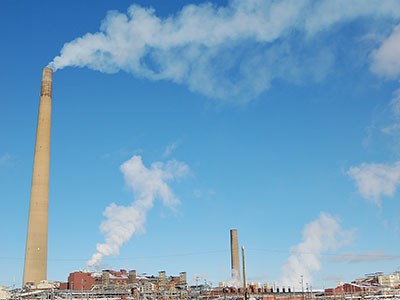A nitrogen dioxide leak at Vale’s Copper Cliff smelter caused some tense moments in Sudbury.
The noxious gas (NOx) was released from the company’s acid plant during a maintenance shutdown, Aug. 13.
Jody Kuzenko, Vale's general manager of production services, said the gas – which is a mixture of nitrogen oxide and nitrogen dioxide – was released when the company's acid reservoir was cleaned with water that morning.
“The release itself should not have happened, and the cause will be investigated,” she said.
The nickel miner said it believes the community was never at risk.
The release prompted Vale to sound an air horn at 6 a.m. to alert nearby Copper Cliff residents to remain in their homes with windows shut and air conditioners turned off.
The sound of the alarm could be heard in downtown Sudbury.
Roads leading into the western parts of the city were also blockaded by police until the company called off its warning at 8:26 a.m.
Kuzenko said the cleaning procedure normally only creates a small, and manageable, amount of the gas. But for reasons the company cannot yet explain, the gas was in a higher concentration than normal, and eventually traveled beyond Vale's property.
While Vale sounded its alarms, nitrogen dioxide readings from the Ministry of the Environment, which are measured in downtown Sudbury, showed levels started to increase by 10 p.m. Aug. 12, and reached a peak of 20 parts per billion by 2 a.m. the next morning.
Kuzenko said the Ministry of the Environment's timelines were inconsistent with Vale's own measurements of the gas.
Kuzenko said the highest reading at the
perimeter of Vale's property found a NOx concentration of 0.5 parts
per million.
The Ministry of Labour considers levels below
three parts per million, over an eight-hour period, to be safe.
“We
were well below the limits that create a risk to personal safety,”
Kuzenko said.
Vale will collaborate with the United Steelworkers
to investigate the incident, find out what the root causes were, and
determine whether the emergency response was appropriate.
When
water interacts with the acid it creates NOx – an orange-yellow gas
that can cause irritation to the eyes, nose, mouth and lungs at low
levels, and serious health complications at high concentrations.
In
an incident unrelated to the NOx gas release, Kuzenko said four
workers received minor injuries from exposure to sulfuric acid during
planned maintenance procedures.
She said the workers were
all treated and no one was seriously harmed.
When asked
about evacuation procedures for Copper Cliff residents in case of an
emergency, Kuzenko said Vale is working with the city to put a plan
in place, but added an evacuation would not have been an appropriate
response Thursday morning, since people were asked to avoid being
outside.



